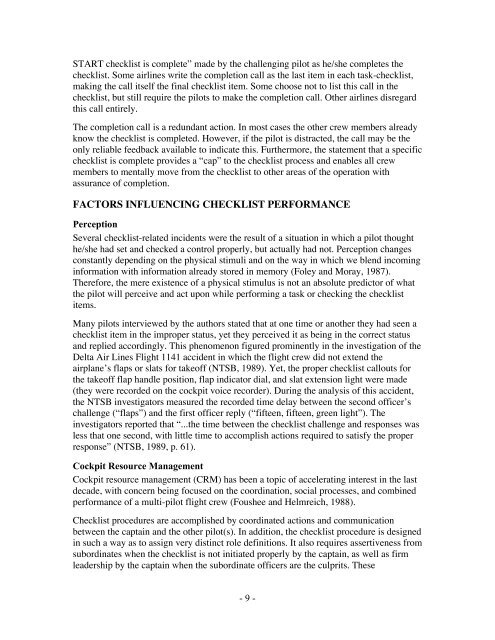COCKPIT CHECKLISTS: CONCEPTS, DESIGN, AND USE - NASA
COCKPIT CHECKLISTS: CONCEPTS, DESIGN, AND USE - NASA
COCKPIT CHECKLISTS: CONCEPTS, DESIGN, AND USE - NASA
You also want an ePaper? Increase the reach of your titles
YUMPU automatically turns print PDFs into web optimized ePapers that Google loves.
START checklist is complete” made by the challenging pilot as he/she completes thechecklist. Some airlines write the completion call as the last item in each task-checklist,making the call itself the final checklist item. Some choose not to list this call in thechecklist, but still require the pilots to make the completion call. Other airlines disregardthis call entirely.The completion call is a redundant action. In most cases the other crew members alreadyknow the checklist is completed. However, if the pilot is distracted, the call may be theonly reliable feedback available to indicate this. Furthermore, the statement that a specificchecklist is complete provides a “cap” to the checklist process and enables all crewmembers to mentally move from the checklist to other areas of the operation withassurance of completion.FACTORS INFLUENCING CHECKLIST PERFORMANCEPerceptionSeveral checklist-related incidents were the result of a situation in which a pilot thoughthe/she had set and checked a control properly, but actually had not. Perception changesconstantly depending on the physical stimuli and on the way in which we blend incominginformation with information already stored in memory (Foley and Moray, 1987).Therefore, the mere existence of a physical stimulus is not an absolute predictor of whatthe pilot will perceive and act upon while performing a task or checking the checklistitems.Many pilots interviewed by the authors stated that at one time or another they had seen achecklist item in the improper status, yet they perceived it as being in the correct statusand replied accordingly. This phenomenon figured prominently in the investigation of theDelta Air Lines Flight 1141 accident in which the flight crew did not extend theairplane’s flaps or slats for takeoff (NTSB, 1989). Yet, the proper checklist callouts forthe takeoff flap handle position, flap indicator dial, and slat extension light were made(they were recorded on the cockpit voice recorder). During the analysis of this accident,the NTSB investigators measured the recorded time delay between the second officer’schallenge (“flaps”) and the first officer reply (“fifteen, fifteen, green light”). Theinvestigators reported that “...the time between the checklist challenge and responses wasless that one second, with little time to accomplish actions required to satisfy the properresponse” (NTSB, 1989, p. 61).Cockpit Resource ManagementCockpit resource management (CRM) has been a topic of accelerating interest in the lastdecade, with concern being focused on the coordination, social processes, and combinedperformance of a multi-pilot flight crew (Foushee and Helmreich, 1988).Checklist procedures are accomplished by coordinated actions and communicationbetween the captain and the other pilot(s). In addition, the checklist procedure is designedin such a way as to assign very distinct role definitions. It also requires assertiveness fromsubordinates when the checklist is not initiated properly by the captain, as well as firmleadership by the captain when the subordinate officers are the culprits. These- 9 -
















